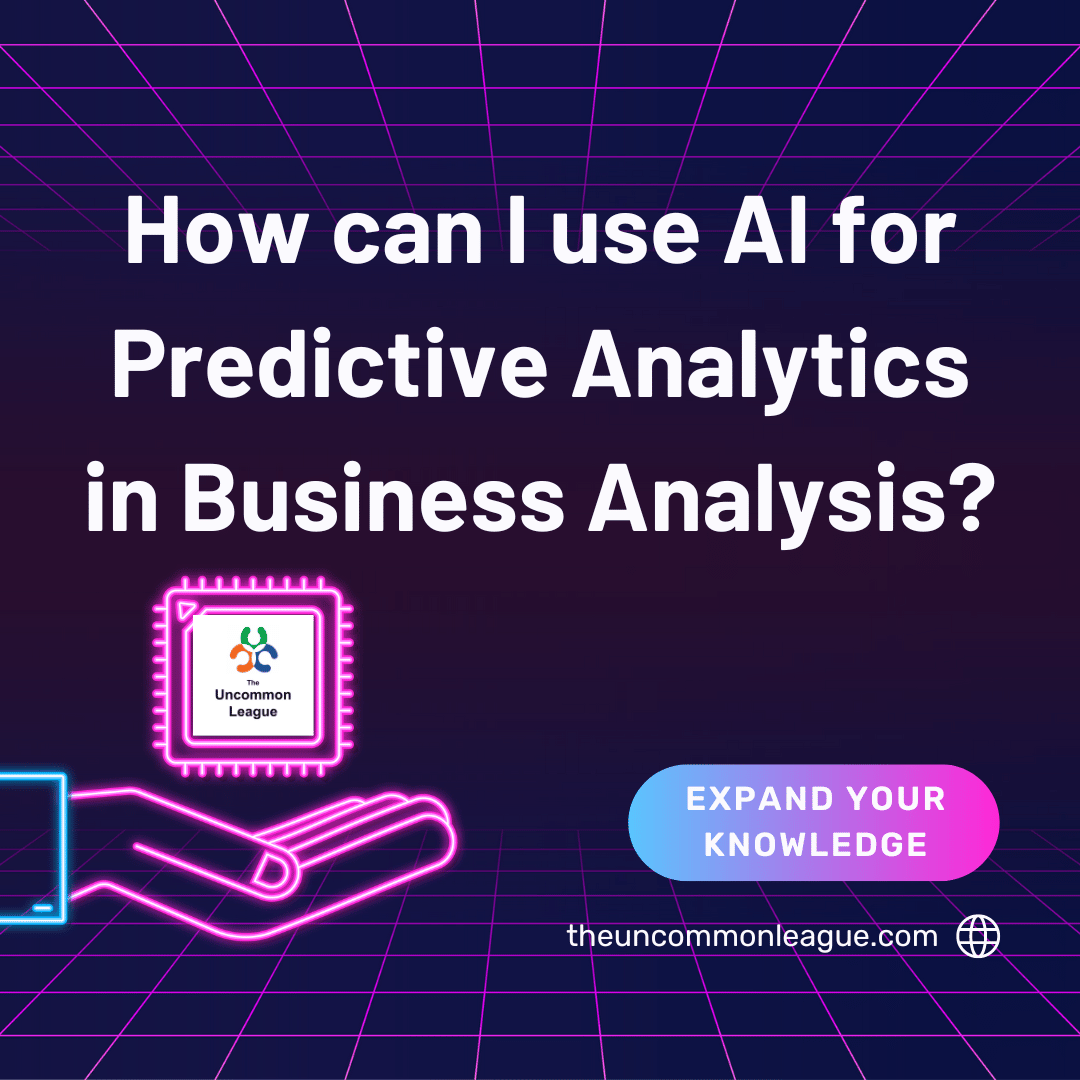How can I use AI for Predictive Analytics in Business Analysis?
Staying ahead often hinges on the ability to anticipate future trends and make proactive decisions. Predictive analytics, powered by artificial intelligence (AI), has emerged as a game-changer in business analysis, offering organizations the ability to forecast outcomes, mitigate risks, and capitalize on opportunities with unprecedented accuracy and efficiency. In this article, we explore how AI can be leveraged for predictive analytics in business analysis, considering current trends and cutting-edge tools that are shaping the future of data-driven decision-making.
The Role of AI in Predictive Analytics
Before delving into the specifics of AI-driven predictive analytics, it's essential to understand the foundational principles and capabilities that underpin this transformative approach to business analysis.
Data-driven Insights: Predictive analytics harnesses the power of historical data to identify patterns, correlations, and trends that can be used to forecast future outcomes. By analyzing vast datasets, AI algorithms can uncover insights that may not be apparent through traditional analysis methods.
Machine Learning Algorithms: At the heart of predictive analytics are machine learning algorithms, which enable AI systems to learn from data, identify patterns, and make predictions without being explicitly programmed. These algorithms continuously improve and refine their predictions over time as they are exposed to more data.
Proactive Decision-Making: Predictive analytics empowers organizations to adopt a proactive approach to decision-making by anticipating future events and trends. By identifying potential risks and opportunities in advance, businesses can take timely actions to mitigate risks, capitalize on opportunities, and gain a competitive edge in the marketplace.
Current Trends in AI-driven Predictive Analytics
To effectively harness AI for predictive analytics in business analysis, it's essential to stay abreast of the latest trends and advancements in this rapidly evolving field.
Explainable AI (XAI): As AI algorithms become increasingly complex and pervasive, there's a growing demand for transparency and interpretability. Explainable AI (XAI) techniques aim to make AI-driven predictions interpretable to humans by providing insights into the underlying factors and variables that influence predictions.
AutoML and Automated Feature Engineering: Automated machine learning (AutoML) platforms streamline the process of building and deploying predictive models by automating tasks such as feature engineering, model selection, and hyperparameter tuning. These platforms democratize predictive analytics by making it accessible to users with varying levels of technical expertise.
Time Series Forecasting: Time series forecasting techniques enable organizations to predict future trends and patterns based on historical time-stamped data. AI algorithms such as recurrent neural networks (RNNs) and long short-term memory (LSTM) networks excel at modeling sequential data and are well-suited for time series forecasting tasks.
Anomaly Detection and Fraud Prevention: AI-powered anomaly detection algorithms can identify unusual patterns or deviations from expected behavior in data, making them invaluable for fraud detection and prevention in various industries such as finance, healthcare, and cybersecurity.
Strategies for Using AI in Predictive Analytics
Now that we've explored the role of AI in predictive analytics and current trends in the field, let's discuss actionable strategies for leveraging AI in business analysis:
Define Predictive Use Cases: Identify specific business problems or opportunities where predictive analytics can add value, such as demand forecasting, customer churn prediction, or inventory optimization. Prioritize use cases based on their potential impact on business outcomes and strategic objectives.
Collect and Prepare Data: Gather relevant data from internal and external sources, ensuring that it is clean, consistent, and structured. Use AI-driven tools and techniques to preprocess and cleanse the data, address missing values, and perform feature engineering to extract meaningful insights.
Select Appropriate AI Models: Choose AI models and algorithms that are suitable for the predictive analytics task at hand. Consider factors such as the type of data, the complexity of the problem, and the desired level of interpretability. Experiment with different models, such as regression, classification, or time series forecasting, to identify the most effective approach.
Train and Validate Models: Train AI models using historical data, splitting the dataset into training and validation sets to assess model performance. Use techniques such as cross-validation and hyperparameter tuning to optimize model accuracy and generalization performance.
Interpret and Act on Insights: Interpret the predictions generated by AI models in the context of business objectives and domain expertise. Consider the implications of predictions for decision-making and strategy, and take appropriate actions to capitalize on opportunities or mitigate risks identified by predictive analytics.
April 15 - 17, 2024 (3 Days)
9:00 am (Central) until 5:00pm (Central)
Online - Live Instructor
Tools for AI-driven Predictive Analytics
A variety of tools and platforms are available to support AI-driven predictive analytics in business analysis, offering capabilities for data preprocessing, modeling, validation, and deployment:
AutoML Platforms: Automated machine learning platforms such as Google AutoML, DataRobot, and H2O.ai automate the process of building and deploying predictive models, making predictive analytics accessible to users with varying levels of technical expertise.
Time Series Forecasting Libraries: Time series forecasting libraries such as Prophet, Statsmodels, and TensorFlow Time Series enable organizations to build and deploy predictive models for forecasting future trends and patterns in time-stamped data.
Anomaly Detection Tools: Anomaly detection tools such as Amazon Fraud Detector, Splunk, and RapidMiner enable organizations to detect and prevent fraudulent activities, anomalies, and deviations from expected behavior in data.
Explainable AI Platforms: Explainable AI platforms such as IBM Watson OpenScale and Microsoft Azure Machine Learning Interpretability provide tools and techniques for interpreting and explaining AI-driven predictions, making them interpretable and transparent to humans.
Anticipate the Future
AI-driven predictive analytics represents a paradigm shift in business analysis, enabling organizations to anticipate future trends, identify opportunities, and mitigate risks with unprecedented accuracy and efficiency. By understanding the foundational principles of predictive analytics, staying informed about current trends, and leveraging the right tools and strategies, businesses can unlock the full potential of AI to drive data-driven decision-making and gain a competitive edge in the marketplace. As AI continues to evolve, embracing innovation and adopting a forward-thinking approach will be essential for businesses seeking to harness the transformative power of predictive analytics in the digital age.
Tags #businessanalysis #ai


